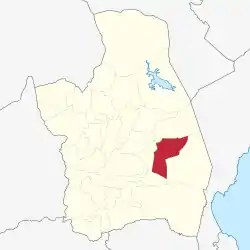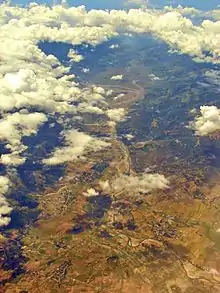Laur | |
|---|---|
| Municipality of Laur | |
 Laur Public Market | |
 Flag  Seal | |
 Map of Nueva Ecija with Laur highlighted | |
OpenStreetMap | |
.svg.png.webp) Laur Location within the Philippines | |
| Coordinates: 15°34′47″N 121°11′11″E / 15.5797°N 121.1864°E | |
| Country | Philippines |
| Region | Central Luzon |
| Province | Nueva Ecija |
| District | 3rd district |
| Founded | January 13, 1917 |
| Named for | Laureana Quijano Tinio, wife of General Manuel Tinio |
| Barangays | 17 (see Barangays) |
| Government | |
| • Type | Sangguniang Bayan |
| • Mayor | Alexander A. Daus |
| • Vice Mayor | John Joe V. Samano |
| • Representative | Rosanna V. Vergara |
| • Municipal Council | Members |
| • Electorate | 25,304 voters (2022) |
| Area | |
| • Total | 295.88 km2 (114.24 sq mi) |
| Elevation | 100 m (300 ft) |
| Highest elevation | 598 m (1,962 ft) |
| Lowest elevation | 58 m (190 ft) |
| Population (2020 census)[3] | |
| • Total | 38,263 |
| • Density | 130/km2 (330/sq mi) |
| • Households | 9,510 |
| Economy | |
| • Income class | 3rd municipal income class |
| • Poverty incidence | 5.69 |
| • Revenue | ₱ 174.3 million (2020) |
| • Assets | ₱ 556.6 million (2020) |
| • Expenditure | ₱ 147.3 million (2020) |
| • Liabilities | ₱ 150.5 million (2020) |
| Service provider | |
| • Electricity | Nueva Ecija 2 Area 2 Electric Cooperative (NEECO 2 A2) |
| Time zone | UTC+8 (PST) |
| ZIP code | 3129 |
| PSGC | |
| IDD : area code | +63 (0)44 |
| Native languages | Tagalog Ilocano |
Laur, officially the Municipality of Laur (Tagalog: Bayan ng Laur, Ilocano: Ili ti Laur), is a 3rd class municipality in the province of Nueva Ecija in Central Luzon region of Philippines. According to the 2020 census, it has a population of 38,263 people.[3] Laur is located at the foothills of the Sierra Madre Mountains.
Laur is 15 kilometres (9.3 mi) from Palayan and 145 kilometres (90 mi) from Manila.
Etymology
The town got its name after the name of the wife of Gen. Manuel Tino, Laureana.
History
Originally, the town was a barrio of the municipality of Bongabon, named San Esteban, after its patron saint, Stephen I of Hungary.
On January 13, 1917, via Executive Order No. 98 by then Governor-General Francis Burton Harrison, Laur was separated as its own town from Bongabon, and named from the wife of Gen. Manuel Tinio, Laureana. Gen. Tinio himself will have the town of Papaya named after him, as "General Tinio" in 1957. Laur borders General Tinio to the south.
Senators Benigno Aquino, Jr. and Jose W. Diokno were kept in solitary confinement for exactly thirty days in 1973 within Fort Magsaysay in Laur. It is now a museum and houses the AFP Center for Human Rights Dialogue.[5]
Geography
Barangays
Laur is politically subdivided into 17 barangays. Each barangay consist of puroks and some have sitios.
- Barangay I (Poblacion)
- Barangay II (Poblacion)
- Barangay III (Poblacion)
- Barangay IV (Poblacion)
- Betania
- Canantong
- Nauzon
- Pangarulong
- Pinagbayanan
- Sagana
- San Fernando
- San Isidro
- San Josep
- San Juan
- San Vicente
- Siclong
- San Felipe
Climate
| Climate data for Laur, Nueva Ecija | |||||||||||||
|---|---|---|---|---|---|---|---|---|---|---|---|---|---|
| Month | Jan | Feb | Mar | Apr | May | Jun | Jul | Aug | Sep | Oct | Nov | Dec | Year |
| Mean daily maximum °C (°F) | 27 (81) |
28 (82) |
29 (84) |
31 (88) |
31 (88) |
30 (86) |
30 (86) |
30 (86) |
29 (84) |
29 (84) |
29 (84) |
27 (81) |
29 (85) |
| Mean daily minimum °C (°F) | 20 (68) |
20 (68) |
21 (70) |
22 (72) |
24 (75) |
24 (75) |
24 (75) |
24 (75) |
24 (75) |
23 (73) |
22 (72) |
21 (70) |
22 (72) |
| Average precipitation mm (inches) | 25 (1.0) |
26 (1.0) |
18 (0.7) |
24 (0.9) |
91 (3.6) |
145 (5.7) |
149 (5.9) |
122 (4.8) |
120 (4.7) |
128 (5.0) |
61 (2.4) |
52 (2.0) |
961 (37.7) |
| Average rainy days | 7.7 | 5.7 | 6.8 | 8.0 | 18.2 | 22.1 | 24.3 | 23.4 | 22.7 | 17.5 | 10.0 | 9.4 | 175.8 |
| Source: Meteoblue[6] | |||||||||||||
Demographics

|
| ||||||||||||||||||||||||||||||||||||||||||||||||
| Source: Philippine Statistics Authority[7][8][9][10] | |||||||||||||||||||||||||||||||||||||||||||||||||
Economy
Government
Local government
Past Mayors of Laur are as follows:
- 1. Pedro Panginen (1917-1919)
- 2. Nemesio Peralta (1919-1922)
- 3. Teodoro Manglicmot (1922-1925
- 4. Timoteo De Guzman (1925-1928)
- 5. Pedro Aquino (1928-1931)
- 6. Florentino Pascua (1931-1934)
- 7. Timoteo De Guzman (1934-1937)
- 8. Tomas Arenas (1938-1940)
- 9. Ladisslao Aquino (Nov. 20-Dec. 21, 1940)
- 10. Felix Petines (1940-1941)
- 11. Jose Villavisa (1946-1951)
- 12. Jorge Padilla (1952-1955)
- 13. Manuel Mesina (1956-1963)
- 14. Gabriel Daus (1964-1971)
- 15. Nicolas Abad (1972-1979)
- 16. Gabriel Daus (1979-1986)
- 17. Antonio Tolentino (1986-1998)
- 18. Blas Canlas (1998-2007)
- 19. Alvaro Daus (2007-2016)
- 20. Alexander Daus (2016-2022)
- 21. Christopher Daus (2022-Incumbent)
See also
References
- ↑ Municipality of Laur | (DILG)
- ↑ "2015 Census of Population, Report No. 3 – Population, Land Area, and Population Density" (PDF). Philippine Statistics Authority. Quezon City, Philippines. August 2016. ISSN 0117-1453. Archived (PDF) from the original on May 25, 2021. Retrieved July 16, 2021.
- 1 2 Census of Population (2020). "Region III (Central Luzon)". Total Population by Province, City, Municipality and Barangay. Philippine Statistics Authority. Retrieved 8 July 2021.
- ↑ "PSA Releases the 2018 Municipal and City Level Poverty Estimates". Philippine Statistics Authority. 15 December 2021. Retrieved 22 January 2022.
- ↑ "Inauguration of the Aquino-Diokno Memorial and the AFP Center for Human Rights Dialogue". 2012-09-21.
- ↑ "Laur: Average Temperatures and Rainfall". Meteoblue. Retrieved 4 May 2020.
- ↑ Census of Population (2015). "Region III (Central Luzon)". Total Population by Province, City, Municipality and Barangay. Philippine Statistics Authority. Retrieved 20 June 2016.
- ↑ Census of Population and Housing (2010). "Region III (Central Luzon)" (PDF). Total Population by Province, City, Municipality and Barangay. National Statistics Office. Retrieved 29 June 2016.
- ↑ Censuses of Population (1903–2007). "Region III (Central Luzon)". Table 1. Population Enumerated in Various Censuses by Province/Highly Urbanized City: 1903 to 2007. National Statistics Office.
{{cite encyclopedia}}: CS1 maint: numeric names: authors list (link) - ↑ "Province of Nueva Ecija". Municipality Population Data. Local Water Utilities Administration Research Division. Retrieved 17 December 2016.
- ↑ "Poverty incidence (PI):". Philippine Statistics Authority. Retrieved December 28, 2020.
- ↑ "Estimation of Local Poverty in the Philippines" (PDF). Philippine Statistics Authority. 29 November 2005.
- ↑ "2003 City and Municipal Level Poverty Estimates" (PDF). Philippine Statistics Authority. 23 March 2009.
- ↑ "City and Municipal Level Poverty Estimates; 2006 and 2009" (PDF). Philippine Statistics Authority. 3 August 2012.
- ↑ "2012 Municipal and City Level Poverty Estimates" (PDF). Philippine Statistics Authority. 31 May 2016.
- ↑ "Municipal and City Level Small Area Poverty Estimates; 2009, 2012 and 2015". Philippine Statistics Authority. 10 July 2019.
- ↑ "PSA Releases the 2018 Municipal and City Level Poverty Estimates". Philippine Statistics Authority. 15 December 2021. Retrieved 22 January 2022.